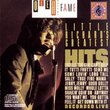| All Artists: Gustav Mahler, Paavo Jarvi, Frankfurt Radio Symphony Orchestra, Alice Coote, Natalie Dessay, Orféon Donostiarra Title: Mahler: Symphony No. 2, Resurrection Members Wishing: 1 Total Copies: 0 Label: Virgin Classics Original Release Date: 1/1/2010 Re-Release Date: 6/8/2010 Album Type: Enhanced Genre: Classical Style: Symphonies Number of Discs: 2 SwapaCD Credits: 2 UPC: 5099969458606 |
Search - Gustav Mahler, Paavo Jarvi, Frankfurt Radio Symphony Orchestra :: Mahler: Symphony No. 2, Resurrection
 | Gustav Mahler, Paavo Jarvi, Frankfurt Radio Symphony Orchestra Mahler: Symphony No. 2, Resurrection Genre: Classical
The Frankfurt Radio Symphony Orchestra (also known as the hr-Sinfonieorchester) became internationally celebrated as a Mahler orchestra in the 1970s and 80s, when Eliahu Inbal was its principal conductor. Now, the Estonian... more » |
Larger Image |
CD DetailsSynopsis
Product Description The Frankfurt Radio Symphony Orchestra (also known as the hr-Sinfonieorchester) became internationally celebrated as a Mahler orchestra in the 1970s and 80s, when Eliahu Inbal was its principal conductor. Now, the Estonian-born Järvi has established a distinctive approach to the Austrian composer's music. As the Frankfurter Allgemeine Zeitung judged after the concert performances of the `Resurrection' in May 2009: "It was to be expected that Järvi's Mahler interpretation would not expend its energies on sentimentality or bombast. He is intent on exploring the wealth of contrasts in this symphony, to clarify structures and to crystallise the often innovative overlaying of compositional processes ... His artistic understanding guaranteed a thoughtful, subtle interpretation, which was crowned by the contribution of the Orféon Donostarria choir from San Sebastian, splendidly accurate in its intonation and nuanced in its dynamics. Natalie Dessay and Alice Coote, meanwhile, impressed with the inspiration and intensity of their expression." The Frankfurter Rundschau felt that "it was as if an angelic lucidity had taken hold of the orchestra," while the Frankfurter Neue Presse stated that: "The HR Symphony Orchestra again provided an impressive demonstration of its command of monumental material of this kind ... Paavo Järvi exercised immaculate control over the huge forces ... and cultivated a sound that was both transparent and imbued with intimations of death and resurrection." Those observations on Järvi's vision of Mahler echo the critical response to the CD of `Mahler Movements': "Even dyed-in-the-wool Mahlerians will hear things anew", proclaimed Journal Frankfurt, while Fono Forum, Germany's leading magazine in the field of classical recorded music, commented thus on the Adagio fragment from the 10th Symphony: "[Järvi'] shapes Mahler's ... final word atmospherically and sculpturally, convincing us of its unique greatness as a freestanding movement, while also developing its bold formal concept in a way which precludes even a moment's doubt as to the validity of the fragment." Järvi, born in 1962, will become Music Director of the Orchestre de Paris from the 2010-11 season. In addition to his post in Frankfurt, he holds the position of Music Director of the Cincinnati Symphony Orchestra and is Artistic Adviser to the Estonian National Symphony Orchestra and Artistic Director of the Deutsche Kammerphilharmonie Bremen. Similarly Requested CDs
|
CD ReviewsVery much a front runner in a very crowded field B. Guerrero | 06/12/2010 (5 out of 5 stars) "Good grief - the hits just keep on coming! With this being a Virgin Classics release, a lot of emphasis is placed on the vocals, so I'd like to start with that first. The chorus, Spain's Orfeon Donostiarra, is the same chorus employed in Claudio Abbado's Lucerne Festival performance (DG) from just several years ago, and what an outstanding job they do - both soft and loud! They don't sound huge, but they sing with great discipline, uniformity, and a surprisingly wide dynamic range for a relatively small chorus. The soprano contribution is rather minimal in the fifth movement, but Natalie Dessay is easily up to her usual high standards. A slight let-down is the mezzo-soprano work of Alice Coote. She's not bad, mind you, but neither is she up to the exalted levels of Birgirt Remmert (Ivan Fischer/Channel Classics), Anna Larsson (Abbado/L.F.O.), or Christianne Stotijn (Haitink/C.S.O.). That's not to mention the outrageous job that Lorraine Hunt Lieberson turned in on the otherwise so-so Tilson Thomas/San Francisco recording. Get the idea? . . . there are tons of options when it comes to Mahler. There are also a number of logistical problems and "extra-musical" ideas when it comes to the Mahler symphonies that employ large forces, so I'd like to tackle those issues next. The end of the symphony - THE most important section for me, as a listener - is done quite well. There's tons of pipe organ, which is essential when you consider that Mahler writes fortissimo with the additional words, "all stops out" (alles werke). After the chorus cuts out, the alternating salvos from the deep bells and two tam-tams (large orchestral gongs of indefinite pitch) - simply marked as being of low and high pitch in the score - are sufficiently clarified. Without getting too technical, The F.R.S.O. uses very heavy, large diameter Wuhan "Chao Gongs" (you can see them quite plainly on the promotional Youtube excerpt). These are marvelous instruments, but, for my taste, they're simply not struck hard enough. You can still somewhat hear them because they're quite large. But a bit more "splash" on the sound wouldn't have hurt. Still, with the excellent and bass-rich sonics that Virgin Classics has provided us, this ends up being one of the better endings in the discography. Especially when you throw in the above mentioned choral work too (and don't forget that organ that sounds like a 727 on take off!). Paavo Jarvi paces everything quite nicely through the closing pages - pulling back on the reins where it's effective, and lunging forward where the music can absorb the additional excitement. In general, Jarvi makes strong contrasts between fast and slow sections throughout the symphony. The most obvious example of this happens in the final minute of the first movement. There, he takes the slow funeral cortege at almost a snail's pace, but then races full speed on the movement's concluding, descending run. At times, these contrasts can sound a tad immature. But then again, we have to remind ourselves that this is only Mahler's SECOND symphony; it shouldn't feel like a bad Bruckner 8th. Anyway, I want get back to those logistical problems. There are several spots in the finale where offstage brass play a very important function. In general, they're a tad too distant on this recording. Before the climax of the fifth movement's long march section, offstage trumpets and percussion (bass drum/cymbals) start out in the far distance, then move forward as we approach the noisy climax to the march. Here, Jarvi starts them out a bit too far, and so they don't move in close enough before the entire orchestra jumps back in at a full fortissimo. The percussion are nearly inaudible as well. While this isn't a deal breaker by any means, it's a logistical issue that so seldom gets executed the way it was fully intended. It's for this reason, along with the differences in mezzos, that I still endorse the Ivan Fischer "Resurrection" on Channel Classics; even if that recording strikes some folks as a bit too objective and slightly cold. It's also more naturally recorded, and that brings me around to the all important issue of sound quality. For the most part, the sound is outstanding here. But it's a bit gimmicky too. The harps, in particular, are pumped way forward during climactic passages. While I like that effect, the two sets of timpani get sucked into the same microphones as well. Fortunately, the timpani playing is spot-on in terms of rhythmic accuracy, tuning, and following Mahler's dynamic outlines. It's sort of an object lesson for budding timpanists, but that's not exactly what Mahler intended either. Still, I'll take a bass-rich recording that's a tad gimmicky than one that ignores the lower end of the audio spectrum altogether. Trust me, that happens. Now for the play-by-play. Mvt.I - Clocking in at 23 minutes, Jarvi very much reminds me of Stokowski and Andrew Litton in this movement. It's a bit spacious, but rhythms are always crisp. Most important, the movement's central climax has plenty of grinding dissonance and physical heft. Here, Jarvi's penchant for big contrasts in tempi comes to the fore. Mvt. II - this Intermezzo type movement is done superbly well. Jarvi proves, once and for all, that conjuring up Viennese coffee house charm doesn't mean having to go slow. The fast sections really move forward. I very much enjoy Jarvi's performance of this movement, clocking in a bit less than 10 minutes. Mvt. III - I prefer that the scherzo proper be taken a tad slower than it is here (Klemperer; Fischer), thus bringing out the ironic humor behind St. Anthony's sermon to those indifferent fishes. But Jarvi positively nails the climax to this movement, with its foreshadow of important things to come in the finale. Those assisted harps make a huge impression at that climax too. Good stuff! Mvt. IV - As previously mentioned, Alice Coote isn't as strong as she probably should be. But Jarvi shapes the brass chorale behind her quite nicely. This is the weakest movement in the performance, but not a deal breaker for me either. Mvt. V - I've already discussed the logistical problems involved. What I didn't mention is that most of the lengthy march section is done exceedingly well, with Jarvi executing subtle and not-so-subtle gear changes along the way. In spite of the offstage brass being a tad too distant, the climax to the march section comes off better than most. The ending, with only very small reservations (the gongs), is one of the best ones you could possibly sample. As previously mentioned, the chorus does a lovely job throughout their lengthy, soft passages as well (before we get to the end). Jarvi's 35 minutes is well within the norm, if that means anything. In spite of the small negatives that I have pointed out, I still feel that this is a very strong front-runner in the Mahler 2 sweepstakes. By all accounts, it's probably more viscerally exciting than the Ivan Fischer on Channel Classics (which I still prefer on the whole). Currently, Paavo Jarvi has become a default "go-to" guy for most standard orchestral literature, and he doesn't disappoint in this colossal side-show of a symphony. These very same forces already have a more-than-decent performance of Mahler 3 that can be fully viewed on Youtube. While certainly not needed, perhaps Virgin Classics could be persuaded to issue that as well." Paavo Jarvi is very assured, and the recorded sound is spect Santa Fe Listener | Santa Fe, NM USA | 06/09/2010 (5 out of 5 stars) "Paavo Jarvi has directed the Frankfurt Radio orchestra since 2006, and it's clear that they play well for him; this new Mahler Second is also captured in exceptionally clear, up-to-date sound. As the product description says, Eliahu Inbal made some notable Mahler recordings with the same orchestra in the days of early digital, but what made them stand out was mostly Denon's unusually good sound (one exception being Inbal's superb Mahler Tenth in the Cooke completion). Every listener will have to find a context for Jarvi's approach here. He isn't out to be more profound, idiomatic, or thrilling than his great predecessors. Yet one gets a sense of real assurance. We've entered a third generation of modern Mahler conducting where, after the era of Bernstein and Karajan, followed by Abbado and Rattle, a conductor in his forties can feel so comfortable with Mahler's music as an everyday diet that he is free to riff on the score at will. In that vein, Jarvi's reading contains gestures you won't recognize from famous Mahler Seconds by Solti, Klemperer, Bernstein, and Mehta. This is more the approach of Gergiev, looking to make his mark through new ideas about phrasing, pacing, and balance. I wasn't in a mood to resist, and so a different reading captured my attention. It's free-wheeling but also sensitive, musical, and interesting. The overall temperature is a bit cool, but we don't get the clinical sterility of Zinman on RCA. The music constantly sits up and wants to be noticed. Generalities about Jarvi's lean textures, his light touch with accents, and his pick up of the pace don't do justice to all the personal touches that appear in passing. By comparison, the blockbuster live reading by the Chicago Sym. under Haitink feels standardized. To give a thumbnail sketch of each movement, the first is a complete success. It is mysterious and at times ethereal; Jarvi offers no emotional earthquakes but cleaves to Mahler's inwardness. The same sense of reverie, almost as if the music is being heard from beyond the grave, continues into the second movement Minuet -- it's captivating and beautifully nuanced. For me, the Scherzo works best when a conductor finds the satiric bite hidden in a deceptively innocent Wunderhorn song, but Jarvi is chipper and light-handed, relying on charm over irony. Fair enough. You'll never hear a quieter, more refined account. To save it from a petty consistency, the brass outbursts are dramatically contrasted, but not too much -- Jarvi never loses his finesse. In the early heyday of stereo, every budding audiophile was waiting for the sumptuous aural feast that is the symphony's second half. Although she sings cleanly, Alice Coote's "Urlicht" solo isn't memorable (she pays little attention to what the words mean), but Jarvi's detailed attention to the orchestral accompaniment is impressive, particularly for a live performance. The first big eruption of sound immediately follows. Here alone Jarvi's approach falters. The last half hour of the Mahler Second cries out for a world-class orchestra rising to the level of exultant epiphany, and the Frankfurt band isn't such an orchestra. Also, the fifth movement, like the finale of the Beethoven Ninth, sustains one long arc from beginning to end, even though there are varied episodes along the way. In his recently released version on the London Phil.'s house label, Klaus Tennstedt unfolds the drama of a soul approaching the gates of Heaven, even during the shivering quieter moments. Jarvi is fine at the episodes but less so at building the long span. I think this music of cosmic redemption doesn't mean that much to him, not in the earthshaking way it did to the composer and the greatest interpreters. Even so, there are many thrills to savor. Natalie Dessay is miked too close to sound properly ethereal, but she's movingly artistic. The chorus is expert, the organ makes a prominent entrance, and the cacophony of bells and orchestra at the climax makes its full impact. IN short, this is a contemporary Mahler Second to be reckoned with." A winner MartinP | Nijmegen, The Netherlands | 06/19/2010 (5 out of 5 stars) "The Frankfurt RSO has earned its Mahler credentials with an often overlooked but exceptionally fine cycle recorded by Denon in the 80s under Eliahu Inbal. In that cycle, however, the Second was one of the weaker spots, (marred, too, to no small extent by Inbal's distinctive singing voice...) so it is nice to hear them set the balance straight in this blazing recording, that has nothing weak about it. Indeed, it is every bit as fine as the magnificent Tennstedt that emerged from the archives recently, and even better than that in the closing pages. Quite different, too, in many ways, so it is good to see two such marvellous releases in short succession.
The first movement is more concerned with lyrical expression than brutal force and may strike some as slightly soft-core. It is, however, extremely beautiful, and very well balanced, sometimes to revealing effect - for instance, the meandering viola line after #9 acquires strong harmonic meaning. It is a pity that Järvi realizes the accelerando in the main theme by slowing down the start of the run rather than speeding up the end of it, and the final run of triplets that concludes the movement sounds rather rushed, but these minor sins are committed by nearly all his colleagues, too. The second movement is very light on its feet, rather fast, clearly conceived as an intermezzo, as opposed to the 'Wucht' accorded to it by Tennstedt. Both approaches are valid and in any case the gossamer playing is a delight. I'm not sure how the timpanist at the beginning of the third movement went about damping his blows, but the result sounds almost like a third blow, a slightly unsettling start to a very fine reading. The sleazy chromatics in the clarinet part simply ooze sarcasm, and the whole movement erupts in a final, rich and dark climax with glorious horns. Alice Coote's Urlicht is as good as any, sympathetic and sincere, modest in a way befitting Mahler's designation of the movement as 'Schlicht'. It leads into a reading of the finale that is nothing short of sensational from beginning to end. The very audible harps add a fascinating touch to the dramatic opening, and again later at the great crisis just before the chorus enters. The off-stage effects are handled to perfection and the playing here is rather more secure than with Tennstedt. The Orfeon Donostiarra sings with great beauty, hushed tone and rich nuance. The very long held fermata's on the opening lines are a peculiar touch which some may find overdone, but which I found rather touching. And the final apotheosis is as splendid as it should be, thunderous organ and clamorous bells very much in evidence. In all, a very uplifting experience, and that is no faint praise for a reading of a work so over-recorded. Add to that the fact that all this is captured in excellent, detailed, richly realistic sound (though at a fairly low level, so turn up the volume), and this is a clear winner." |

 Track Listings (5) - Disc #1
Track Listings (5) - Disc #1


